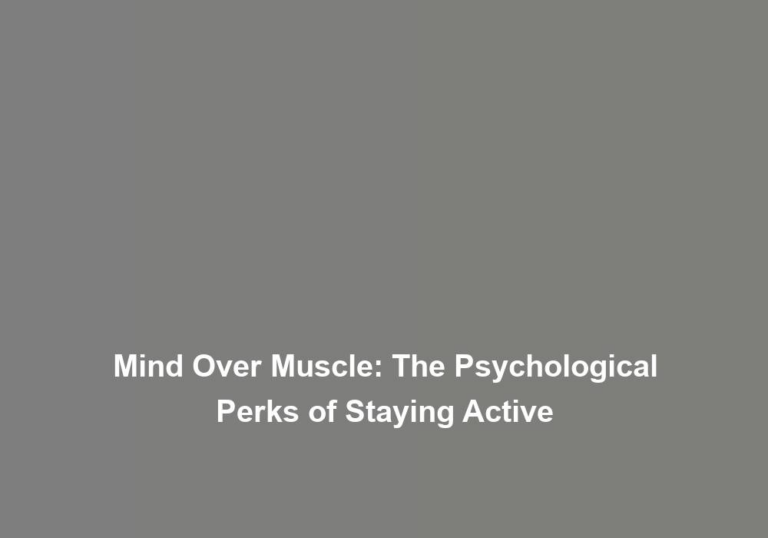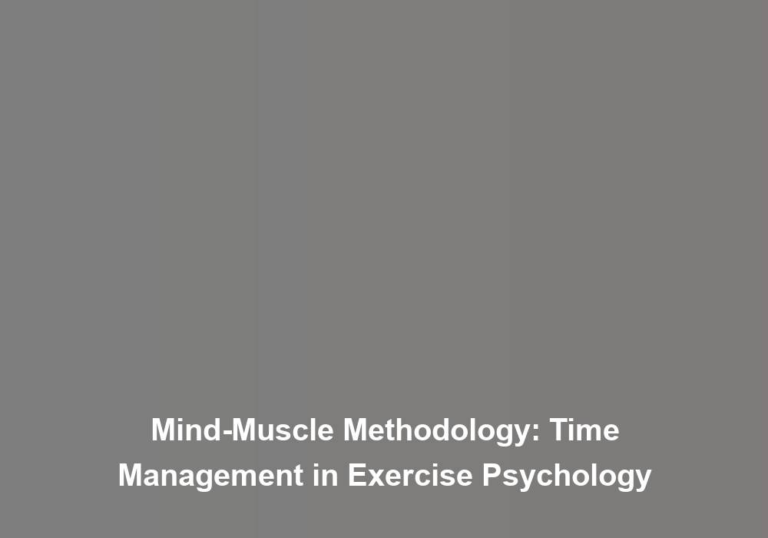Finding Your Drive: Innovative Motivation Strategies in Exercise Psychology
As you lace up your sneakers and step onto the path of self-improvement, itG??s essential to understand the intricate mechanisms that drive your motivation. In the realm of exercise psychology, innovative strategies are constantly evolving to keep you engaged and committed to your fitness journey. From the power of positive reinforcement to the utilization of cutting-edge technology, there are a multitude of tactics waiting to be explored. These strategies not only propel you forward but also tap into the depths of your psyche, offering a personalized approach to motivation. So, how can you unlock these innovative motivation strategies and propel your fitness journey to new heights?
The Power of Positive Reinforcement
Positive reinforcement is a powerful tool for motivating individuals to maintain an exercise routine and achieve their fitness goals. When you receive positive feedback or rewards for exercising, it can significantly increase the likelihood of you continuing to engage in physical activity. This is because positive reinforcement works on the principles of behavior modification, encouraging you to repeat the desired behavior, in this case, exercising regularly.
Behavior modification involves changing patterns of behavior by using various reinforcement techniques. In the context of exercise psychology, positive reinforcement plays a vital role in shaping your exercise habits. For instance, if you receive praise or acknowledgment for consistently attending workout sessions, it reinforces the behavior of exercising and makes it more likely for you to continue doing so.
Cognitive restructuring is also an important aspect of positive reinforcement. When you receive positive feedback for your efforts in the gym, it can reshape your thoughts and attitudes towards exercise. You start associating exercise with positive experiences and feelings, which in turn, motivates you to continue with your fitness routine.
Leveraging Technology for Personalized Motivation
You can take advantage of personalized fitness apps and wearable motivation devices to enhance your exercise experience. These technological tools can provide tailored workout plans, track your progress, and offer real-time feedback to keep you motivated and engaged. By leveraging technology, you can create a personalized approach to fitness that aligns with your unique goals and preferences.
Personalized Fitness Apps
Personalized fitness apps leverage technology to provide tailored motivation, tracking, and guidance for individuals seeking to improve their exercise habits. These apps offer:
- Customized workouts: Tailored exercise routines based on your fitness level and goals.
- Interactive tracking: Real-time monitoring of your progress to keep you engaged and accountable.
- Behavior change: Strategies to help you develop sustainable healthy habits and overcome barriers.
- Personalized coaching: Guidance from virtual trainers or coaches to support and motivate you throughout your fitness journey.
With these personalized fitness apps, you can find a sense of belonging to a community of like-minded individuals, receive individualized support, and track your progress in a way that feels uniquely tailored to your needs.
Wearable Motivation Devices
Leveraging technology to provide personalized motivation, motivational wearables offer a seamless integration of fitness tracking and real-time feedback, allowing you to stay engaged and accountable in your exercise routines. These wearable devices go beyond simple tracking, providing tailored nudges and positive reinforcement to support your behavioral change and exercise adherence. By using wearable technology, you can receive instant encouragement and progress updates, fostering a sense of belonging to a community of like-minded individuals striving for their fitness goals. The continuous support and motivation from these devices help you build and maintain healthy habits, making the journey towards a healthier lifestyle more enjoyable and sustainable. With motivational wearables, you can experience a personalized and interactive approach to fitness that keeps you motivated and committed to achieving your exercise goals.
Exploring Intrinsic Motivation Psychology
Understanding intrinsic motivation in psychology is essential for comprehending the internal drive that fuels individualsG?? engagement in physical activity. Intrinsic motivation, as proposed by self-determination theory in motivation psychology, involves engaging in activities for the inherent satisfaction and enjoyment they bring, rather than for external rewards or pressures. Here are some key points to consider when exploring intrinsic motivation psychology:
-
Autonomy: Recognize the importance of autonomy in fostering intrinsic motivation. Providing individuals with a sense of autonomy in their exercise choices and goals can significantly enhance their intrinsic motivation to engage in physical activity. Empower individuals to make decisions about their workouts and encourage them to pursue activities that align with their interests and preferences.
-
Competence: Emphasize the development of competence in exercise psychology. Helping individuals build their skills and confidence in various physical activities can boost their intrinsic motivation. Creating opportunities for individuals to experience progress and mastery in their workouts can enhance their sense of competence and intrinsic motivation.
-
Relatedness: Highlight the significance of fostering a sense of relatedness in exercise environments. Building a supportive and inclusive community where individuals feel connected and valued can enhance their intrinsic motivation to participate in physical activity. Encourage social interactions, group workouts, and teamwork to promote a sense of belonging and connection.
-
Intrinsic vs.-?extrinsic motivation: Distinguish between intrinsic and extrinsic motivation in the context of exercise psychology. Help individuals recognize the differences between engaging in physical activity for internal enjoyment and satisfaction (intrinsic motivation) versus pursuing it for external rewards or pressures (extrinsic motivation).
Understanding and incorporating these aspects of intrinsic motivation psychology can contribute to creating a more fulfilling and sustainable exercise experience, fostering a sense of belonging and motivation from within.
Understanding Goal Setting and Achievement
You need clear goals and a way to track your progress to achieve success in exercise psychology. Setting specific and measurable goals helps you stay focused and motivated. By tracking your progress, you can see how far youG??ve come and make adjustments to reach your desired outcomes.
Clear Goals
Setting clear and specific goals is a fundamental aspect of achieving success in exercise psychology. When you visualize your goals, it helps create a clear path to success. Here are some key points to consider when setting clear goals:
- Specificity: Define your goals with precision and clarity.
- Measurability: Set goals that are quantifiable and trackable.
- Achievable: Establish realistic goals that are within your reach.
- Relevance: Ensure your goals are aligned with your values and long-term objectives.
Progress Tracking
After setting clear goals, the next crucial step is tracking your progress towards achieving them, which plays a significant role in your overall success in exercise psychology. Progress tracking involves monitoring your behavior change and self-monitoring your actions and habits. By keeping a record of your efforts, whether itG??s through a fitness journal, an app, or simply marking a calendar, you can visually see how far youG??ve come and where you need to focus more. This process not only provides a sense of accomplishment but also helps in identifying patterns and areas for improvement. It reinforces the belief that your actions are leading to positive change, which is essential for maintaining motivation and sustaining long-term commitment to your exercise routine. Remember, progress tracking is a powerful tool for staying on track and achieving your fitness goals.
Harnessing Social Support and Community
How can individuals leverage social support and community to enhance their motivation for exercise and physical activity? Building a network of support can significantly impact your drive to stay active. Here are some effective ways to harness social support and community to boost your motivation:
-
Group Dynamics: Engage in group exercise classes or join a sports team. The camaraderie and friendly competition within a group setting can fuel your motivation and commitment to regular physical activity.
-
Team Motivation: Team up with friends, family, or colleagues to set fitness goals together. Working towards a common objective fosters a sense of unity and can provide the encouragement needed to stay motivated.
-
Social Accountability: Share your fitness journey on social media or join online communities focused on health and wellness. Being transparent about your goals and progress creates a sense of accountability, as your peers can offer support and encouragement along the way.
-
Peer Support: Surround yourself with individuals who prioritize physical activity. Whether itG??s finding a workout buddy or participating in community events, the encouragement and understanding from like-minded individuals can be a powerful motivator.
Implementing Mindfulness and Mental Training
Leveraging social support and community for exercise motivation can also involve implementing mindfulness and mental training techniques to enhance your overall commitment to physical activity. Engaging in mindful movement, such as yoga or tai chi, can help you develop a stronger mind-body connection, allowing you to fully experience and appreciate the physical sensations and benefits of exercise. This heightened awareness can significantly increase your motivation and enjoyment of physical activity, making it more likely that you will stick with your exercise routine.
In addition to mindful movement, mental resilience can be cultivated through visualization techniques. By vividly imagining yourself overcoming obstacles and achieving your fitness goals, you can strengthen your determination and perseverance. Visualization can also help reduce anxiety and increase self-confidence, empowering you to push through challenges and setbacks in your fitness journey.
| Mindful Movement | Visualization Techniques |
|---|---|
| Yoga | Mental Rehearsal |
| Tai Chi | Goal Imagery |
| Pilates | Outcome Visualization |
| Qigong | Positive Affirmations |
| Mindful Walking | Imagery with Relaxation |
Incorporating mindfulness and mental training into your exercise routine can deepen your sense of belonging to a community of like-minded individuals who value holistic well-being. By nurturing your mind-body connection and mental resilience, you can enhance your motivation and commitment to exercise, ultimately leading to a more fulfilling and sustainable fitness journey.
Conclusion
In conclusion, finding your drive through innovative motivation strategies in exercise psychology can lead to powerful and persistent progress. By harnessing the power of positive reinforcement, leveraging technology for personalized motivation, exploring intrinsic motivation psychology, understanding goal setting and achievement, harnessing social support and community, and implementing mindfulness and mental training, you can pave the path to peak performance.







